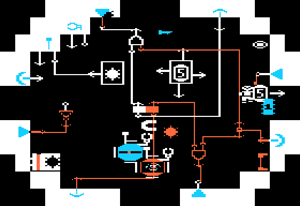There was a brilliant computer game back in the day for Apple ][+ called “Robot Odyssey.” It was my first exposure to programming and the notion that instead of solving puzzles, you could build robots to solve puzzles on your behalf (and you could even build robots to build robots… 10-year-old mind blown…). This became the seed of a philosophy which evolved over my career and has served me well in my entrepreneurial and business endeavors. I challenge you to take any problem that currently confronts you and view it through this lens: instead of imaging a solution, imagine a factory you could build that would generate future solutions to this and other similar problems in a sustainable way. This is the essence of systems thinking and its leap of abstraction. Developing the ability to see problems from a systems thinking perspective is arguably the most advantageous muscle entrepreneurs and knowledge workers alike can build.
Anyone can brute force a problem and solve it one-off but that approach has two shortcomings: a) it’s not resilient b) it doesn’t scale well. In order to address these shortcomings your answer should ideally not be the solution to this instance of the problem, but rather the factory that intelligently generates the solution. This is all very abstract so let me make it concrete by sharing two examples of how I have applied this thinking in the past.
Problem: How to convey tribal knowledge to new sales people?
As the Director of Sales & Marketing for Pagely, I’ve been performing a dual role of generating and servicing leads. As we scale as a company, it becomes critical to cleave off operational roles and be less of a quarterback and more of a playmaker on the sidelines. Easier said than done when the sales process and tribal knowledge of the product exists in your head and is distributed amongst silo’d repositories and consists of 1000’s of edge cases. My challenge at Pagely is in disseminating this tribal knowledge in a scaleable, repeatable way as we build up our sales organization. This will involve conveying unfathomable memory banks of experience from past sales interactions to new salespeople and doing it in a way that doesn’t monopolize me from continuing to build the apparatus by which we generate and service leads.
So the question becomes, “How can I extract the gist of all sales interactions into a resource that can grow over time and in a sustainable way where the trainees are the ones actually building it?” The “factory” I came up with to address this challenge is our new knowledge base. This is a new resource we haven’t even formally announced yet but is the sum of all pre-sales questions and answers since I started with Pagely in August ’15. I had our three interns cull through my past recorded sales calls, internal chats and email history of sales exchanges to extract questions from customers and my responses. We used a Google Sheet as a work queue. I go in and curate the Q&A there, tag and categorize it, approve it and then have one of the interns moving approved articles into the public knowledge base.
 Now that this resource exists, the training process for new sales people is to review all articles in the KB. As they begin interacting with customers they can reference the KB. If, and only if, the question isn’t addressed by the KB, they come to me or ask the question on our internal chat to determine the answer and then add to the KB. In this way the KB now serves as an exhaustive and authoritative hub for our salespeople with the aggregation of all sales knowledge. Not only that but it yields a byproduct benefit of exposing a self-serve mechanism for visitors who would prefer to research their own questions without contacting sales. It also should provide an ongoing boost to SEO and it’s all done in a sustainable way that builds and curates itself while simultaneously accruing extra SEO juice in the form user-generated followup questions in the comments.
Now that this resource exists, the training process for new sales people is to review all articles in the KB. As they begin interacting with customers they can reference the KB. If, and only if, the question isn’t addressed by the KB, they come to me or ask the question on our internal chat to determine the answer and then add to the KB. In this way the KB now serves as an exhaustive and authoritative hub for our salespeople with the aggregation of all sales knowledge. Not only that but it yields a byproduct benefit of exposing a self-serve mechanism for visitors who would prefer to research their own questions without contacting sales. It also should provide an ongoing boost to SEO and it’s all done in a sustainable way that builds and curates itself while simultaneously accruing extra SEO juice in the form user-generated followup questions in the comments.
Robot #1 wired up– bam! Now let’s explore another scenario in a totally different realm.
Problem: How to grow a guerilla marketing “street team” in remote locales?
I started a company called Shortsaleopedia back in 2010. It was designed to help other people facing foreclosure learn about the short sale option and then pair them up with competent realtors to take them through the process in a systematized fashion. We had a realtor network of 250 vetted certified short sale experts around the US, a proprietary methodology for achieving higher success rates and some process automation software for babysitting transactions through to completion and alerting stakeholders as key dates approached. So far so good. The main challenge was one of awareness: growing the business was a matter of expanding the pie and reaching the folks who were facing foreclosure and weren’t yet aware of the short sale option. We tried a number of online marketing strategies for accomplishing this but the one that proved most effective was handwritten notes left on the doors of at-risk properties.
This worked well in Phoenix as we were able to pull 30-60-90 day foreclosure notice records, load the addresses into routing software and canvas 40 houses in a neighborhood in a single afternoon. But how the heck would we perform this at scale in other locales? We needed the factory that could solve this going forward.
 The solution we developed was a website called “Drivin’ for Dollars.” We posted jobs that paid based on verified flyer delivery. We solicited from Craigslist and Task Rabbit and had the applicants watch a video and apply for the position. We then generated 20 flyers using the 30-60-90 data for a nearby neighborhood, sent the PDF to the local Kinko’s and had the applicant run a trial route snapping a photo of the flyer on the door at each of the locations. We could spot check based on the EXIF data of the photo to ensure they actually delivered the flyers to the address. We paid $1/flyer and applicants who successfully completed the trial batch were awarded larger and larger runs.
The solution we developed was a website called “Drivin’ for Dollars.” We posted jobs that paid based on verified flyer delivery. We solicited from Craigslist and Task Rabbit and had the applicants watch a video and apply for the position. We then generated 20 flyers using the 30-60-90 data for a nearby neighborhood, sent the PDF to the local Kinko’s and had the applicant run a trial route snapping a photo of the flyer on the door at each of the locations. We could spot check based on the EXIF data of the photo to ensure they actually delivered the flyers to the address. We paid $1/flyer and applicants who successfully completed the trial batch were awarded larger and larger runs.
Robot #2 for building remote guerilla marketing street teams- wired and operational!
Summary and Further Reading
Systems Thinking is a mindset which can be learned. It’s a matter of beginning to see the world in terms of stocks & flows and leverage points. I highly recommend reading the book Thinking in Systems by Donella Meadows. Systems thinking is how you learn to extract yourself from operational quicksand and become the playmaker. In a future post I’ll further decompose some of the above strategies and teach the “horse race” and “airlocks” design patterns that can be used in novel situations to accomplish a more “factory” approach to problem-solving.
If you’ve “developed a solution factory” or a have systems thinking approach wisdom of your own to share, please do so via comment below.
